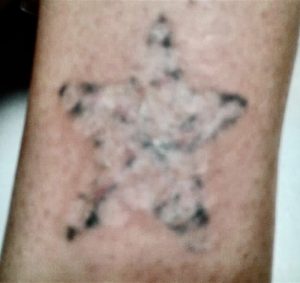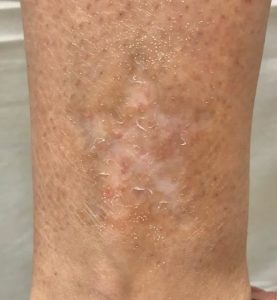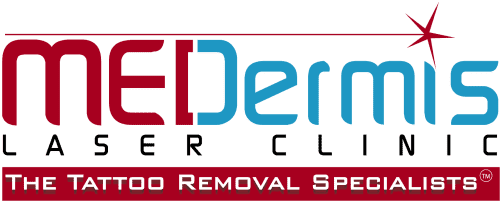
5 Types of Tattoo Removal Methods (and which to avoid)
The history of tattoo removal is as old as tattoos themselves. For centuries, people have tried many crude and painful tattoo removal methods. Some of these methods are still in use today, and we believe it’s important to ensure our clients are informed on the details and risks involved.
DIY, Natural, or Budget Options for Tattoo Removal
Deciding to remove an old tattoo you got when you were younger is a big step toward a clean slate, but choosing which method you’re going to pursue can be challenging when there are so many tattoo removal options. Do those cheap drugstore creams really work? Is rubbing the layers of skin away with dermabrasion a safe option? Should you invest in the latest laser technologies?
If you’ve been toying with the idea of getting a tattoo removed, you’ve also likely come across various DIY methods. Unfortunately, in all our years of removing tattoos, we’ve encountered various clients that opted for at-home and “natural” removal methods — all of which are ineffective and dangerous.
The conversation around tattoo removal is pretty straightforward – yes, you have some tattoo removal options, but many are unsafe and can cause more trouble for you down the line. While laser tattoo removal is the safest and most effective way to get rid of a tattoo, we understand that these situations can make people desperate.
Why DIY Methods of Removing Tattoos Are Dangerous
We’ve been in the business of helping people remove old tattoos long enough to understand that some people may be desperate to remove their ink. However, doing it at home or without the supervision of a professional will certainly cause more harm than good. Common complications from at-home removal methods can include infection, permanent scarring, hyperpigmentation, and hypopigmentation.
Over a decade ago, there were very different tattoo removal methods that were popular, like infrared treatments. We still have patients who come in that are hoping to clean up the damage caused by the other treatments they’ve tried over the years. In particular, we still get a lot of patients who attempted infrared tattoo removal in the past and encountered side effects, like burning, infections, and extended recovery times. This treatment looked like someone had applied a cigarette multiple times to the tattoo.
 Before: a star ankle tattoo post-infrared treatments 13 years ago. |  After: results after two laser removal treatments with MEDermis. |
We don’t share these stories to shock or scare you, but to warn you of the real danger in choosing the wrong tattoo removal method.
Top 5 Most Common Tattoo Removal Methods
1. Salabrasion & Dermabrasion
The oldest tattoo removal method still in use today is salabrasion. It consists of the abrasion of the epidermis and dermis with a salt-based solution. Dermabrasion is very similar except it uses a mechanical method that consists of the abrasion of the epidermis and dermis with a rotating mechanical instrument. Salabrasion and dermabrasion are very painful and cause visible long-term damage to the epidermis.
2. Skin Excision
Skin excision refers to the surgical removal of the tattooed skin. This method leaves a scar, the size of which may vary depending on the size of the tattoo. Excision can be an OK method for small tattoos, but is somewhat difficult or impossible for larger areas. Skin grafts can also be performed with skin excision.
3. Subcutaneous Injections of Solutions
Subcutaneous injections of glycolic acid-based solutions or other liquid solutions involve injecting these solutions under the skin, so that they may affect the ink of the tattoo. These solutions often have an effect on the epidermis and dermis and may leave long-term scars or burn-like marks. Moreover, the effectiveness of this method is not consistently proven, since the ink-solution mixture cannot easily be expelled from the dermis to the epidermis.
4. Tattoo Removal Cream
A tattoo removal cream may be attractive due to its low cost and perceived ease of use.
However, it is extremely difficult to remove ink from the dermis with a cream, regardless of type (peeling, TCA, or other). In best-case scenarios, they may superficially fade inks located in the epidermis.
Learn more about tattoo removal creams >>
5. Laser Tattoo Removal After a Prior Removal Method
If you have already attempted to remove your tattoo with a laser and the tattoo is still there, don’t fret. The MEDermis team is highly experienced in treating clients with past types of removal that may have damaged or scarred the skin. We can remove any visible ink left and in some cases we are able to reduce the scar tissue with the laser itself and by applying a microdermabrasion treatment to help the skin reproduce the collagen.
Learn more about the technology we use at MEDermis >>
The Best, Safest Way to Remove Ink: Laser Tattoo Removal
When considering tattoo removal, keep in mind that today, laser tattoo removal is regarded as the safest and most successful method for removing ink. The lasers work by targeting the darker pigment in your skin then breaking the particles into smaller pieces that the body’s immune system eliminates overtime. With laser tattoo removal, you can expect the following benefits:
- Fewer treatments: Typically, patients need only three to seven treatments to completely remove their tattoo. What determines the number of sessions you’ll require is the age, coloring, location, and ink density of your tattoo.
- Faster sessions: MEDermis Laser Clinic has perfected laser removal, and you can expect sessions that are only 15 to 30 minutes long. Sessions will be scheduled every six to eight weeks.
- Lessened side effects: Unlike other removal methods, with laser removal, you can expect little to no scarring at the tattoo site or on the surrounding skin.
- Effective removal of most colors: In the past, lighter colors like greens, yellows, and turquoise were quite difficult to remove. Now, with the latest laser technology, we can target those colors — you’ll see virtually no trace.
How Successful Is Laser Tattoo Removal?
Laser tattoo removal is the most effective technique for removing tattoo ink compared to other methods, because it can safely remove all tattoo types and color pigments with little to no scarring. Alternative methods — like salabrasion, surgical removal, and dermabrasion — are often ineffective, leave scars or damaged skin, and have uncomfortable side effects like bleeding, swelling, or infection.
Protect Yourself from Unsafe Tattoo Removal
If you’re seeking real results, getting laser treatments by an experienced professional is your best bet. Laser treatments target ink particles in the skin and cause them to break up into smaller particles that your body’s immune system will dispose of.
When done with the right equipment, and by a trained expert, you can get the results you’re after without any side effects. Unfortunately, we’ve found that people generally go for the quickest and cheapest option to remove their tattoo. You will get what you pay for, and cheap/fast removal will give you cheap/bad results.
When it comes to protecting your skin, it’s worth the wait! Our team of Certified Licensed Laser Technicians will walk you through the entire process, with your safety as the top priority.
Call the Tattoo Removal Specialists Today! Have questions about how laser tattoo removal works? Or are you ready to schedule your FREE consultation? Get in touch with MEDermis Laser Clinic today by calling our Austin clinic at 512-637-5277, the San Antonio clinic at 210-402-4030, or by filling out our online contact form.
